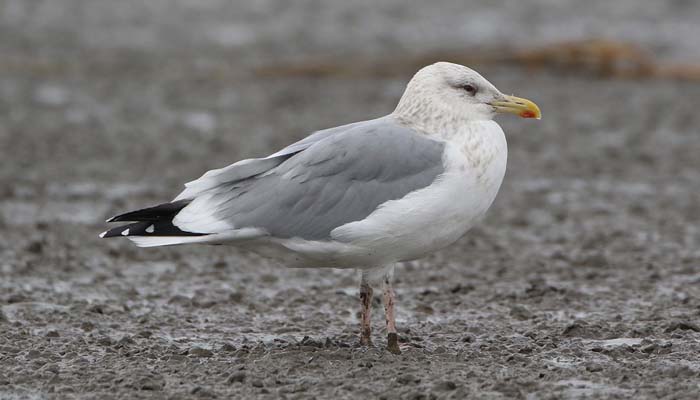
English: Glaucous Gull
Russian: Бургомистр
Mongolian: Мөсний цахлай
German: Eismowe
French: Goeland bourgmestre
Japanese: シロカモメ (Shiro-kamome)
Body length: 63-68 cm
Wing span: 138-158 cm.
Nests singly or in loose
colonies on cliffs, islands, or other open ground near sea. South of breeding range, uncommon
or rare (mostly Oct-Apr), mainly near coast among flocks of other large gulls.
Food in summer mainly fish, eggs and young of other birds; in winter, mainly
waste from fishing ports, rubbish tips, etc.
Identification: Four
age-groups. Glaucous and Iceland Gulls are the only large gulls with whitish
primaries. Adults have paler grey upperparts than Herring Gulls; 1st and 2nd years
in fresh plumage are rather uniformly pale ochrous-brwon or cafй-au-lait-coloured,
with fainter and finer barring on upperparts and wing-coverts than other large
gulls; unmarked pale or white flight-feathers diagnostic at all ages, obvious
in flight, especially from below, when they appear strikingly (but beware of
moulting Herring Gull in Aug-Nov). Because they are similar in plumage at all
ages, telling Glaucous from Iceland rests entirely on difference in size,
structure, bill pattern (on 1st years), and bill colour (on some adults and 3rd
years). Given good views, identification of most is easy: Glaucous is obviously
or slightly larger and longer-legged than Herring Gull and more heavily built,
with large bill, small eye, and sloping forehead and often angled hindcrown
giving a mean, aggressive look; as a rule, the bill is as long as or longer
than the length of the (short) projection of primaries beyond the tail-tip.
Glaucous Gull is also correspondingly broader-winged, longer-necked and
larger-headed, and more lumbering in flight than Iceland, but the structural and
size differences are often more difficult to appreciate in flight than on the
ground. Identification of 1st year is made easier because of diagnostic difference
in bill pattern: Glaucous invariably has bill two-thirds pale (pinkish) with sharply
demarcated black tip (Iceland has more extensive black tip, shading into often
only slightly paler base).
Adult’s orbital ring is yellow (reddish on Iceland).
Occasional small or small-looking Glaucous or large-looking Iceland can be more
difficult; in such cases, bill pattern (on 1 years) and bill-length
/primary-projection difference are the most useful features. Caution is necessary
over all-white albinistic individuals of other species, paler-than-normal
(so-called leacistic) immature Herring Gulls, and Glaucous x Herring Gull
hybrids. All-white albinistic gulls are rare, however, and in any case no
Glaucous or Iceland is ever entirely pure white (although some much-faded 1st
and 2nd years may appear so at long range). Leucism and hybridity show on
immature gulls through the outer primaries, secondary bar or tail-band being at
least slightly darker than the general colour of the rest of the plumage, and
adult hybrids will show dark markings on the wing-tip; pure Glaucous and
nominate Iceland never show such features.